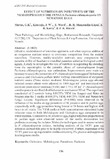Effect of nutrition on infectivity of the nematophagous the fungus pochonia chlamydosporia on nematode eggs

View/
Date
2011-09Author
Hirsch, P. R.
Kerry, B. R
Manzanilla-Lepez, R. H.
Mutua, E. G.K2 ., Kimenju, J. W2 . Ward
Mutua, G.K
Kimenju, J. W.
Ward, E.
Language
enMetadata
Show full item recordAbstract
Effective establishment of microbes applied to soil often requires addition of
an exogenous nutrient source to overcome competition from the resident
microflora. However, readily-available nutrients may compromise the
parasitic ability of facultative microbial parasites added as biological control
agents. A study to investigate the role of nutrition in regulating the switching
from the saprotrophic to the parasitic phase of nematophagous fungus
Pochonia chlamydosporia, was undertaken. Improvements were made to a
bioassay to assess the parasitism of P chlamydosporia on eggs of Meloidogyne
javanica and Globodera pallida under varying concentrations of exogenous
nutrient source (Yeast extract medium). Meloidogyne janica eggs obtained
infected tomato plants were adjusted to 1000 eggs ml' and inoculated with
sterilised yeast extract medium (YEM) and 2.75 x 104 ml' P chlamydosporia
conidiospores in sterilised distilled water to a volume of 10m!. The experiment
constituted of 2 controls being 0.0125% YEM (no fungus) and Water (no
fungus) plus the 3 media (0.00625% YEM, 0.0125% YEM and Water) by 6
fungal isolates. Significant differences (P<O.OOI) were observed on the
influence of the media on egg parasitism of M. javanica and G. pallida eggs,
respectively with, egg parasitism being lowest at 24 hours and highest at 48
hours in all media. The YEM media at both concentrations stimulated higher
infection rates on both Meloidogyne and Globodera eggs compared to the
water medium. Compared to M. javanica eggs, higher infection proportions on
G. pallida eggs were observed across all the media demonstrate host
preferences among the isolates. Molecular techniques used to assess variation
in P chlamydosporia isolates, including analysis of the VCPl gene egg
infection showed this gene to be highly conserved. Further, expression of the
VCPl gene was up-regulated in media containing 2% glucose and suppressed
in nitrogenous media.
Citation
Optimimization of Agricultural Value Chains for sustainable DevelopmentSponsorhip
National Council of Science and Technology, The Kenya Seed CompanyPublisher
Faculty of Agriculture, University of Nairobi
Description
aGRO 2011 Biennial Conference presention
